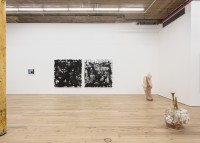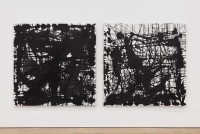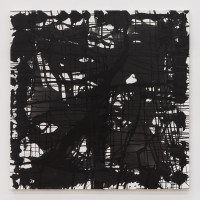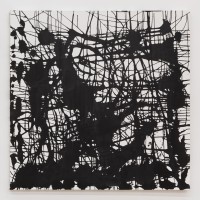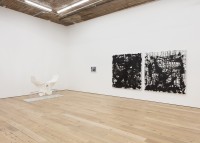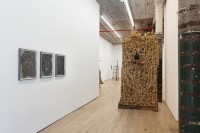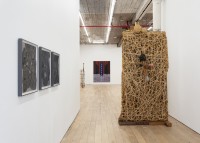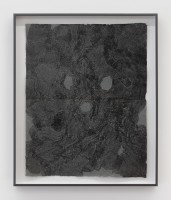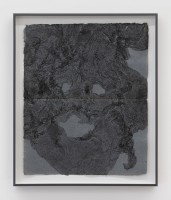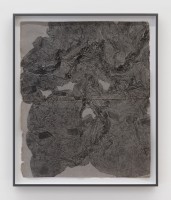LOST & FOUND
Martos Gallery, New York, NY
February 5 - March 27, 2021
A Lost & Found is a room where items that have gone astray are turned in and stored to await being claimed by their owners. Though all sorts of things are lost, simple representations of a hat, an umbrella and a glove are featured on signs seen in train stations or recalled from a scene in an old movie, usually a mystery. Signage meant to be more universally recognized pictures an umbrella and a small suitcase below a question mark, or a question mark overlaid on a suitcase, as in airport terminals worldwide. Signs will also simply announce Lost Property, uniting ownership and object orphandom in terms of belongings. Attendants are trained to be helpful, even empathetic, since those they briefly meet across the counter may be in a state of distress or agitated anticipation, hopeful that their missing items will magically appear from the inner recesses of the Lost & Found, a room many of us have been curious about since childhood. The attendant, for those in search of items absentmindedly left behind, and possibly for themselves, depending on the level of drama and its outcome, may briefly reign as the hero who saves the day. The child reunited with a beloved stuffed pal who slipped from sleepy arms unnoticed, wipes away big tears to manage a tentative, dampened smile. Such an ending also acknowledges its opposite, when an attendant returns empty-handed, or its inversion, when the happier end may have been conspired. Just the other day a friend related being with a man who, seeing a sign for a Lost & Found, went over, hoping to retrieve a pair of gloves. He described them to the attendant, being sure to mention they were of high quality, and black. When a very nice pair of gloves was soon brought out, he lit up, identified them, offered his thanks, and they went on their way. Moments after leaving, he told the woman that in fact he had never lost any gloves, quite satisfied with himself having acquired an expensive pair for free. Whether or not this story has any correspondence with our current situation, societally speaking, the image of a man's clenched fist encased in a black leather glove, is entirely up to the reader.
What is the Lost & Found in art? Is there such a place? Is it a state of mind, of curiosity? Existing everywhere at all times? To occasion, over and again, a parallel with life, its flow? The tide comes in and the tide goes out, and what washes up randomly upon the shore? As many go about putting a lost year behind us, we wonder how to find our way back to ourselves, to one another, to those gone. Belongings. What belongs to us, and to whom do we belong? Can a gallery be thought of as a Lost & Found? Artists have long engaged with things discovered by chance, explored the assisted ready made and unmade by plan, have collected objects as well as words, the dual poetics of recycling, articulated a visual language of their own device or translation. We know that more items in a Lost & Found will remain unclaimed than encounter reunion. Such a place becomes an archive of sorts, forgotten items lining the shelves and racks, left behind absent-mindedly, perhaps intentionally? Beyond the usual books, bags, wallets and phones, items more commonly gone astray, others more rare will appear, to evoke the performative: a surfboard, a violin laid in its velvety case. Travelers who have arrived at their destinations, far from points of departure, can't easily cross the air terminal or station concourse once they're miles away; only upon arrival do many discover something's gone. And what about the taking of an item that belongs, or belonged, past tense, to someone else? Rather than a purloined letter, a pair of gloves, disembodied as it were, handed over just like that (more readily than a watch or a ring), not stolen exactly, but deceptively acquired. To lose one's train of thought is not necessarily a misfortune, for it's in those unexpected turns that we derive the greater surprise, finding our way through an unfamiliar route taken. How did we get here? and Who are we now? This somewhat circuitously brings to mind a short, free-associative text from a time long past, a time before identity theft:
"I've been told by the authorities here to 'write about art please you're supposed to be the art critic.' Well, that's right and I don't see why there's a problem. Richard Kostelanetz just called me up to remind me of the Meredith Monk and Yvonne Rainer dance programs in February at the Billy Rose Theatre. I think Rainer is doing the most intelligent things that could happen in dance today. Someone called Saul Ostrow sent me a carbon copy of a letter which said only: I AM NOT NOR HAVE I EVER BEEN GREGORY BATTCOCK. That's very frightening and reminded me of what Jill Johnston said in last week's Voice about taking a subway ride and ending up in the lost and found ..."
